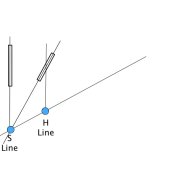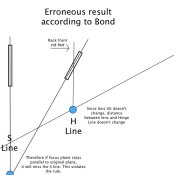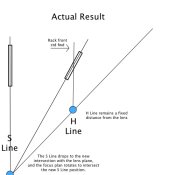chung
Member
Very insightful link for understanding the S priciple and H rule
http://www.trenholm.org/hmmerk/VuCamTxt.pdf
http://www.trenholm.org/hmmerk/VuCamTxt.pdf
I found this illustration, http://www.trenholm.org/hmmerk/HMbook18.html, I've never really understood the hingeline concept until I found this. There is no mention of the movement of the lens forward or back, but it only stands to reason (for my understanding) anyway. When a rigid lens is focused, the plane of focus moves forward or backward parallel to itself, tilting the lens should not change that relationship (it seems anyway), so I tend to believe what Bond is saying, it's enough to get one cross-eyed though.
Actually I believe it reinforces what I stated before. If the distance between the film plane and the lens changes without a change in tilt, according to these rules the plane of sharpest focus must rotate around the hinge line regardless of whether the change is due to front or rear standard movement. Think about it. If the plane of sharpest focus must touch both the H and S lines, and the lens tilt doesn't change (which is the only way the H line moves vertically) the result must be a change of angle of the plane of sharpest focus, unless the lens is not tilted relative to the film plane, because the vertical position of the S line will change.
So Bond is incorrect.

Very insightful link for understanding the S priciple and H rule
http://www.trenholm.org/hmmerk/VuCamTxt.pdf
Bond is referencing a tilted lens that is focused accurately but on the wrong plane-----so, moving the lens to increase or decrease the distance of the lens from the camera's back moves the plane of focus parallel to itself. But moving the camera's back to increase or decrease the distance from a tilted lens causes the plane of sharp focus to rotate at the hinge line. My study on it is taking me to a different place, I guess I have to disagree with you. But I'm still studying on it, so things could change...............
Keep studying.....
Then the essential question to be answered is this assertion made by Bond:
"...a tilted plane of focus moves parallel to itself when the focus knob is turned, just as it does with a rigid camera."
I don't pretend to know anymore about it, it's intriguing though.
First to your previous comment: I'm not spending time on this just to "be" right.



Chuck, I'll try this with my own crude figures.
Consider the following situation, with forward tilt. The Scheimpflug Line (S Line) is one of the blue dots (a line seen end-on is just a dot. It sits at the intersection of the Film Plane, the Lens Plane, and the Focal Plane. The Hinge Line (H Line) is also a blue dot. It sits a fixed distance vertically from the lens, and its distance is determined by the amount of tilt of the lens:
View attachment 51402
Now we will rack forward the front standard. Bond claims the focal plane will remain parallel to the former focal plane. But that would result in the following:
View attachment 51403
Clearly that can't be true, because the focal plane must intersect at the S line (the blue dot). The S line is in a different place, because the front tilted lens has changed position relative to the film plane, because it has moved forward. Thus the intersection is lower now. Thus, the focal plane has to rotate as seen in this correct result:
View attachment 51404
(Forgive the crude graphics, its the best I could do on short notice. Click the images to see them full size.)
Bond is claiming that a tilted plane of sharp focus (refer to as the focus plane) moves parallel to itself, not the focal plane. The focal plane is a line parallel to the lens plane but one focal length in front of the lens------so, to obey the H-Rule, the focal plane, the focus plane, and the parallel-to-film lens plane must converge at the H-line. Taking part of your suggestion, as I draw a line parallel to the focus plane, it continues to intersect the S-line and the parallel-to-film lens plane, but comes off the focal plane line, giving the appearance that an adjustment of the tilt angle is needed to re-establish the H-Line.
By this, then, it appears to me that, while the S-Rule is being obeyed with parallel movement of the focus plane , the H-Rule is not. Merklinger says that is possible, but the camera will not be in focus until both the S-Rule and the H-Rule are obeyed simultaneously. When re-reading Bond's statement, he is either:
- wrong, as you say
- he is right but fails to convey it properly in the article
- he is right, but I have totally misinterpreted his statement
I have to assume that when he says "....a tilted plane of focus moves parallel to itself....when the focus knob is turned...." that he means the front standard. Because, moving the back standard "rotates" the focus plane at the H-Line, and I view a rotation movement as different from a parallel movement.
For what it is worth, when I wrote "focal plane" above I meant "plane of sharpest focus". My bad for trying to save some typing.
The bottom line though as can be seen by the figure is that the light doesn't know whether it is the front or read standard that moves. Both movements accomplish the same optical result, of change the distance between lens and film, as shown. I think it is plain to see that the same figure represents the result of either a front forward movement or a back rearward movement.
CPorter said:This is going to make using my LF camera so much more enjoyable

Knowing the theory and math of a view camera is a good thing, but
in the field practical knowledge helps me out more.
I learned to focus the view camera in a practical way just by viewing this
video. It is in the video section I think of apug but here is a link anyway :
http://www.youtube.com/watch?v=gR4m70xr9mE
| Photrio.com contains affiliate links to products. We may receive a commission for purchases made through these links. To read our full affiliate disclosure statement please click Here. |
PHOTRIO PARTNERS EQUALLY FUNDING OUR COMMUNITY:  |


